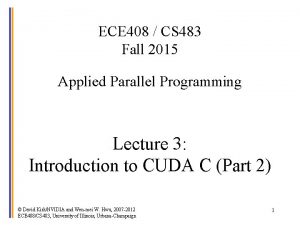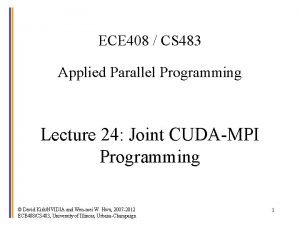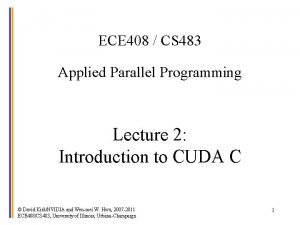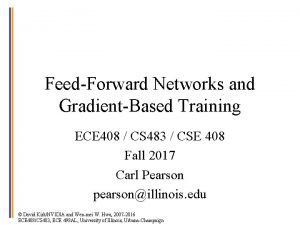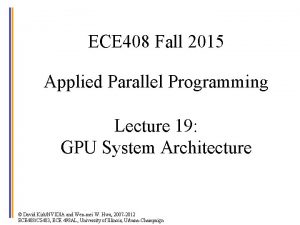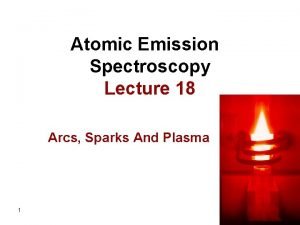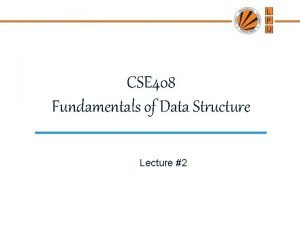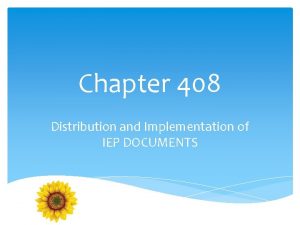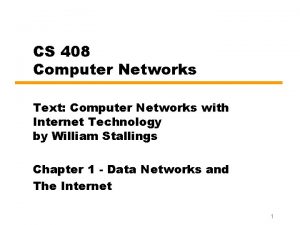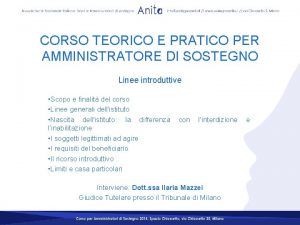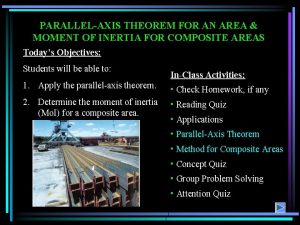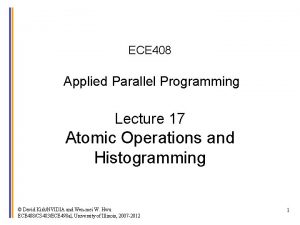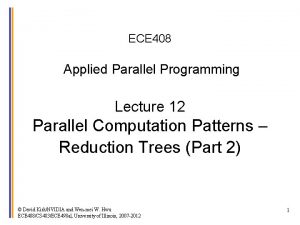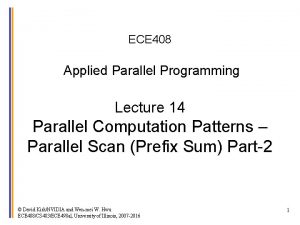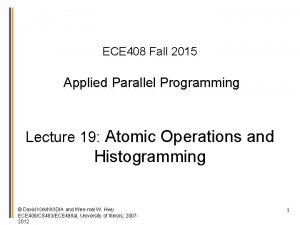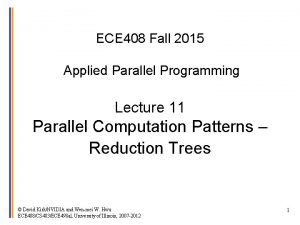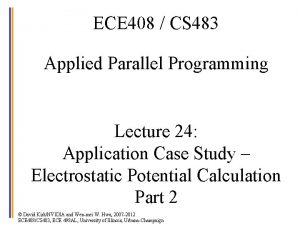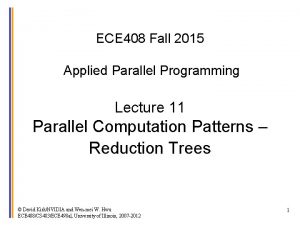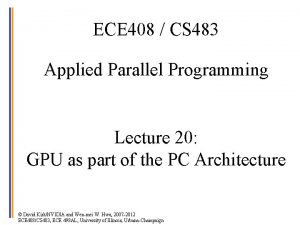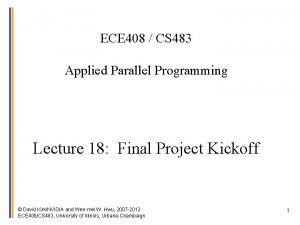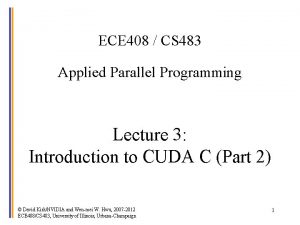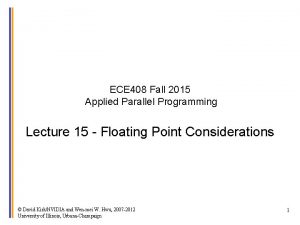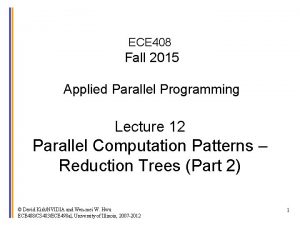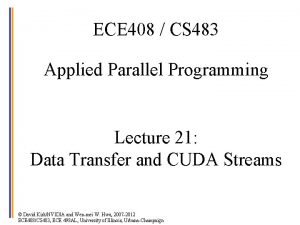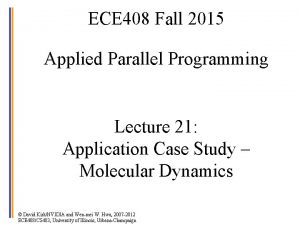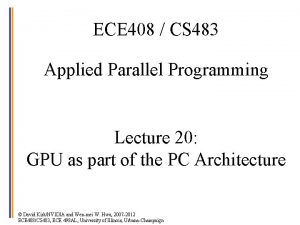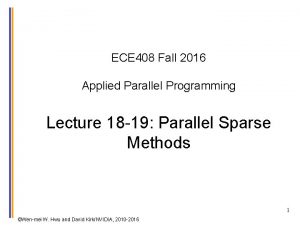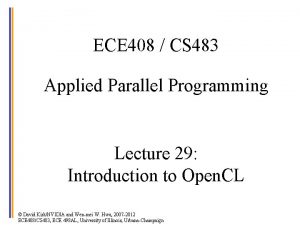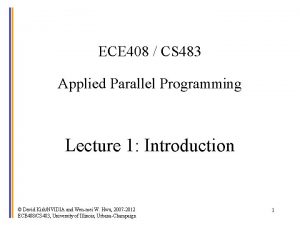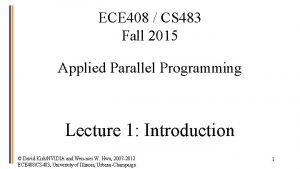ECE 408 Applied Parallel Programming Lecture 19 Atomic




















![Atomics in Shared Memory Requires Privatization • Create private copies of the histo[] array Atomics in Shared Memory Requires Privatization • Create private copies of the histo[] array](https://slidetodoc.com/presentation_image_h2/41783b30e6a56c1b4af4b684cc51a00d/image-21.jpg)




- Slides: 25

ECE 408 Applied Parallel Programming Lecture 19: Atomic Operations and Histogramming - Part 2 © David Kirk/NVIDIA and Wen-mei W. Hwu ECE 408/CS 483/ECE 498 al, University of Illinois, 20072012 1

Objective • To learn practical histogram programming techniques – Basic histogram algorithm using atomic operations – Privatization © David Kirk/NVIDIA and Wen-mei W. Hwu ECE 408/CS 483/ECE 498 al, University of Illinois, 20072012 2

Review: A Histogram Example • In phrase “Programming Massively Parallel Processors” build a histogram of frequencies of each letter • A(4), C(1), E(1), G(1), … • How do you do this in parallel? – Have each thread to take a section of the input – For each input letter, use atomic operations to build the histogram © David Kirk/NVIDIA and Wen-mei W. Hwu ECE 408/CS 483/ECE 498 al, University of Illinois, 20072012 3

Iteration #1 – 1 st letter in each section P R O G R A MM I N G Thread 0 Thread 1 M A S S I V E L Y Thread 2 P Thread 3 1 2 1 A B C D E F G H I J K L M N O P Q R S T U V © David Kirk/NVIDIA and Wen-mei W. Hwu ECE 408/CS 483/ECE 498 al, University of Illinois, 20072012 4

Iteration #2 – 2 nd letter in each section P R O G R A MM I N G Thread 0 Thread 1 M A S S I V E L Y Thread 2 P Thread 3 1 1 1 3 1 1 A B C D E F G H I J K L M N O P Q R S T U V © David Kirk/NVIDIA and Wen-mei W. Hwu ECE 408/CS 483/ECE 498 al, University of Illinois, 20072012 5

Iteration #3 P R O G R A MM I N G Thread 0 Thread 1 M A S S I V E L Y Thread 2 P Thread 3 1 1 1 1 A B C D E F G H I J K L M N O P Q R S T U V © David Kirk/NVIDIA and Wen-mei W. Hwu ECE 408/CS 483/ECE 498 al, University of Illinois, 20072012 6

Iteration #4 P R O G R A MM I N G Thread 0 Thread 1 M A S S I V E L Y Thread 2 P Thread 3 1 1 1 3 1 1 2 A B C D E F G H I J K L M N O P Q R S T U V © David Kirk/NVIDIA and Wen-mei W. Hwu ECE 408/CS 483/ECE 498 al, University of Illinois, 20072012 7

Iteration #5 P R O G R A MM I N G Thread 0 Thread 1 M A S S I V E L Y Thread 2 P Thread 3 1 1 1 3 1 1 2 2 2 A B C D E F G H I J K L M N O P Q R S T U V © David Kirk/NVIDIA and Wen-mei W. Hwu ECE 408/CS 483/ECE 498 al, University of Illinois, 20072012 8

What is wrong with the algorithm? © David Kirk/NVIDIA and Wen-mei W. Hwu ECE 408/CS 483/ECE 498 al, University of Illinois, 20072012 9

What is wrong with the algorithm? • Reads from the input array are not coalesced – Assign inputs to each thread in a strided pattern – Adjacent threads process adjacent input letters P R O G R A MM I N G M A S S I V E L Y Thread 0 Thread 1 Thread 2 Thread 3 1 1 A B C D E F G H I J K L M N O P Q R S T U V © David Kirk/NVIDIA and Wen-mei W. Hwu ECE 408/CS 483/ECE 498 al, University of Illinois, 20072012 P 10

Iteration 2 • All threads move to the next section of input P R O G R A MM I N G Thread 0 Thread 1 M A S S I V E L Y Thread 2 P Thread 3 1 © David Kirk/NVIDIA and Wen-mei 1 W. Hwu 2 1 1 2 University of Illinois, 2007 AECE 408/CS 483/ECE 498 al, B C D E F G H I J K L M N O P Q R S T U V 2012 11

A Histogram Kernel • The kernel receives a pointer to the input buffer • Each thread process the input in a strided pattern __global__ void histo_kernel(unsigned char *buffer, long size, unsigned int *histo) { int i = thread. Idx. x + block. Idx. x * block. Dim. x; // stride is total number of threads int stride = block. Dim. x * grid. Dim. x; © David Kirk/NVIDIA and Wen-mei W. Hwu ECE 408/CS 483/ECE 498 al, University of Illinois, 20072012 12

More on the Histogram Kernel // All threads handle block. Dim. x * grid. Dim. x // consecutive elements while (i < size) { atomic. Add( &(histo[buffer[i]]), 1); i += stride; } } © David Kirk/NVIDIA and Wen-mei W. Hwu ECE 408/CS 483/ECE 498 al, University of Illinois, 20072012 13

Atomic Operations on DRAM • An atomic operation starts with a read, with a latency of a few hundred cycles © David Kirk/NVIDIA and Wen-mei W. Hwu ECE 408/CS 483/ECE 498 al, University of Illinois, 20072012 14

Atomic Operations on DRAM © David Kirk/NVIDIA and Wen-mei W. Hwu ECE 408/CS 483/ECE 498 al, University of Illinois, 20072012 • An atomic operation starts with a read, with a latency of a few hundred cycles • The atomic operation ends with a write, with a latency of a few hundred cycles • During this whole time, no one else can access the location 15

Atomic Operations on DRAM • Each Load-Modify-Store has two full memory access delays – All atomic operations on the same variable (RAM location) are serialized time internal routing DRAM delay transfer delay atomic operation N © David Kirk/NVIDIA and Wen-mei W. Hwu ECE 408/CS 483/ECE 498 al, University of Illinois, 20072012 DRAM delay . . transfer delay atomic operation N+1 16

Latency determines throughput of atomic operations • Throughput of an atomic operation is the rate at which the application can execute an atomic operation on a particular location. • The rate is limited by the total latency of the readmodify-write sequence, typically more than 1000 cycles for global memory (DRAM) locations. • This means that if many threads attempt to do atomic operation on the same location (contention), the memory bandwidth is reduced to < 1/1000! © David Kirk/NVIDIA and Wen-mei W. Hwu ECE 408/CS 483/ECE 498 al, University of Illinois, 20072012 17

You may have a similar experience in supermarket checkout • Some customers realize that they missed an item after they started to check out • They run to the isle and get the item while the line waits – The rate of check is reduced due to the long latency of running to the isle and back. • Imagine a store where every customer starts the check out before they even fetch any of the items – The rate of the checkout will be 1 / (entire shopping time of each customer) © David Kirk/NVIDIA and Wen-mei W. Hwu ECE 408/CS 483/ECE 498 al, University of Illinois, 20072012 18

Hardware Improvements (cont. ) • Atomic operations on Fermi L 2 cache – medium latency, but still serialized – Global to all blocks – “Free improvement” on Global Memory atomics time internal routing . . data transfer atomic operation N © David Kirk/NVIDIA and Wen-mei W. Hwu ECE 408/CS 483/ECE 498 al, University of Illinois, 20072012 data transfer atomic operation N+1 19

Hardware Improvements • Atomic operations on Shared Memory – Very short latency, but still serialized – Private to each thread block – Need algorithm work by programmers (more later) time internal routing . . data transfer atomic operation N+1 © David Kirk/NVIDIA and Wen-mei W. Hwu ECE 408/CS 483/ECE 498 al, University of Illinois, 20072012 20
![Atomics in Shared Memory Requires Privatization Create private copies of the histo array Atomics in Shared Memory Requires Privatization • Create private copies of the histo[] array](https://slidetodoc.com/presentation_image_h2/41783b30e6a56c1b4af4b684cc51a00d/image-21.jpg)
Atomics in Shared Memory Requires Privatization • Create private copies of the histo[] array for each thread block __global__ void histo_kernel(unsigned char *buffer, long size, unsigned int *histo) { __shared__ unsigned int histo_private[256]; if (thread. Idx. x < 256) histo_private[threadidx. x] = 0; __syncthreads(); © David Kirk/NVIDIA and Wen-mei W. Hwu ECE 408/CS 483/ECE 498 al, University of Illinois, 20072012 21

Build Private Histogram int i = thread. Idx. x + block. Idx. x * block. Dim. x; // stride is total number of threads int stride = block. Dim. x * grid. Dim. x; while (i < size) { atomic. Add( &(private_histo[buffer[i]), 1); i += stride; } © David Kirk/NVIDIA and Wen-mei W. Hwu ECE 408/CS 483/ECE 498 al, University of Illinois, 20072012 22

Build Final Histogram // wait for all other threads in the block to finish __syncthreads(); if (thread. Idx. x < 256) atomic. Add( &(histo[thread. Idx. x]), private_histo[thread. Idx. x] ); } © David Kirk/NVIDIA and Wen-mei W. Hwu ECE 408/CS 483/ECE 498 al, University of Illinois, 20072012 23

More on Privatization • Privatization is a powerful and frequently used techniques for parallelizing applications • The operation needs to be associative and commutative – Histogram add operation is associative and commutative • The histogram size needs to be small – Fits into shared memory • What if the histogram is too large to privatize? © David Kirk/NVIDIA and Wen-mei W. Hwu ECE 408/CS 483/ECE 498 al, University of Illinois, 20072012 24

ANY MORE QUESTIONS? © David Kirk/NVIDIA and Wen-mei W. Hwu ECE 408/CS 483/ECE 498 al, University of Illinois, 20072012 25
 Cs483 uiuc
Cs483 uiuc Cs 483
Cs 483 Ece 408
Ece 408 Ece 408
Ece 408 Ece 408
Ece 408 01:640:244 lecture notes - lecture 15: plat, idah, farad
01:640:244 lecture notes - lecture 15: plat, idah, farad Atomic emission spectroscopy lecture notes
Atomic emission spectroscopy lecture notes Cse 408
Cse 408 408(b)2
408(b)2 Usace section 408
Usace section 408 Nyc doe sesis help desk
Nyc doe sesis help desk Cs 408 sabancı
Cs 408 sabancı Pub 408
Pub 408 Art 408 cc
Art 408 cc Ce 408
Ce 408 Is atomic mass and relative atomic mass the same
Is atomic mass and relative atomic mass the same Periodic trends in the periodic table
Periodic trends in the periodic table Atomic radius trends
Atomic radius trends Abundance calculation chemistry
Abundance calculation chemistry Difference between atomic mass and atomic number
Difference between atomic mass and atomic number Atomic number vs atomic radius
Atomic number vs atomic radius C programming lecture
C programming lecture The parallel-axis theorem for an area is applied between
The parallel-axis theorem for an area is applied between Parallel axis theorem
Parallel axis theorem Cloud computing lecture
Cloud computing lecture Perbedaan linear programming dan integer programming
Perbedaan linear programming dan integer programming
